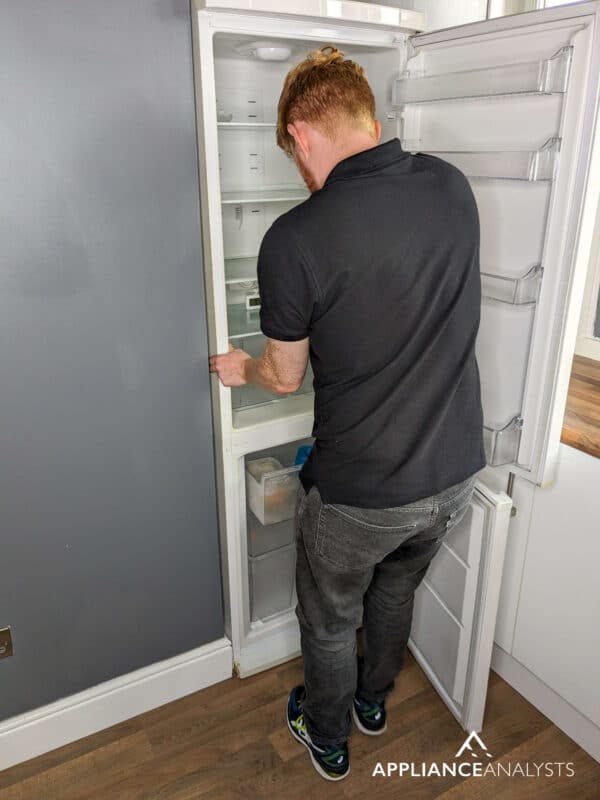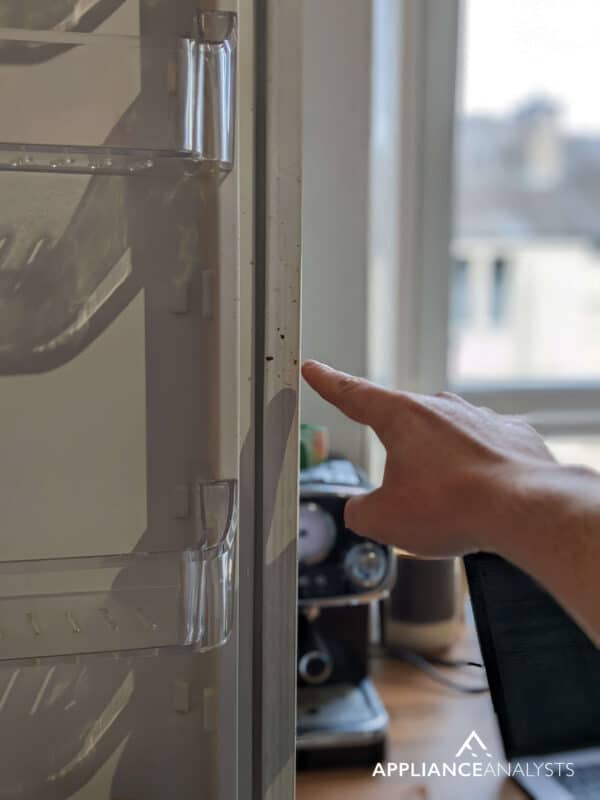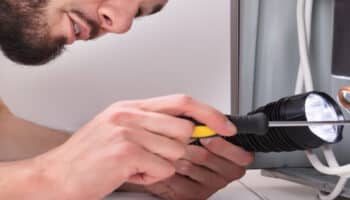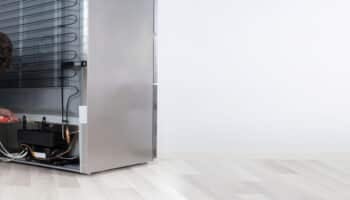Condensation building up in your fridge is trouble. The same goes for condensation on the outside. Both of these can lead to food spoilage and can even cause water damage in your home.
Thankfully, fixing these condensation problems isn’t too difficult. In this article you’ll find all 10 ways to solve fridge condensation, so we can make sure you’re not causing water to build up in your home.
To stop condensation in your fridge you need to try setting your thermostat to a lower setting, unclog the drain, keep the fridge less full, and give the fridge room to breathe. It’s also worth checking the fridge condensation isn’t from energy saving settings, or damaged gaskets.
That’s the short answer, but there’s plenty of details on each of the solutions. I’ll walk you through all of them below.
If that sounds good, then let’s dive in.
What You’ll Need
Most of the fixes in this list don’t need any tools. However, a few of them need some common tools or easy to find replacement parts. Here’s a complete list of everything you’re going to need for our step by step tutorial.
- Flathead screwdriver
- Replacement fridge gasket
- Drain hole tool (or another mechanical drain cleaner)
- Dehumidifier
How to Fix Condensation In A Fridge
We’re going to start a tutorial by taking care of the condensation building up on the outside of your fridge.
#1 Just Wait
Here’s your first step. Make a cup of coffee, read a book, or catch up on your favorite TV shows and just wait. Really. It’s that easy.
Some condensation build up inside of our homes is natural. A small amount of condensation that doesn’t last very long is no threat to your fridge or your home.
If the condensation is minor and goes away quickly, all you need to do is wait it out and the weather will correct itself.
#2 Check Your Energy-Saver Options
Modern fridges are packed with smart, energy-efficient settings. These are typically an advantage for modern-day consumers. They help people who are looking to save money and also lower their personal carbon footprint. However, one of these settings can cause condensation to build up on your fridge.
Your fridge has anti-sweat heaters that prevent condensation from building up. The energy saver option on your fridge might keep these anti-sweat heaters off. If you’re noticing too much condensation building up, turn off your energy saver settings until the condensation has gone away.
#3 Give the Fridge Some Room
We usually back the fridge right up against the wall, but this isn’t actually the best way to set up your fridge.
Your fridge needs a good current of air around it in order for it to stay cool and eliminate condensation. If you’re noticing too much water building up on the outside of your fridge, try back and get a few inches away from the wall. This will give the air more space to circulate around your fridge. This will help the condensation to evaporate more quickly.

#4 Try a Dehumidifier
Dehumidifiers lower the relative humidity in the room. If you live in a very humid climate, you should consider using a dehumidifier in your kitchen.
This will help lower the humidity and keep it off of your fridge. Fridges are an ideal surface for building up condensation in very humid climates. If things are getting hot and muggy in your home, a dehumidifier can keep the condensation from building up on your fridge. A dehumidifier will also stop condensation on your windows and help prevent mold and mildew in your home. It’s a win all around!
#5 Damaged Gasket Seals
This next fix supplies the humidity inside the fridge and outside the fridge. It’s especially useful if you’re experiencing humidity in both places.
There should be a rubber gasket that seals the door closed on your fridge. Over time, this gasket can become brittle and crack or fall out of the door frame. When this gasket fails, humidity can start to build up on the inside and outside of your fridge.

Here are steps that you can take to replace your fridge gasket.
- Remove the old gasket by popping it out of place with a flat head screwdriver and slowly pulling it out of the door
- Use a cleaning solution to clean up the fridge door and allow it to dry
- Insert the new gasket buy a lining up the corner and popping in one corner first
- Slowly and firmly pressed the new gasket into place
If you want to get any replacement part – or see how much one would cost – click to enter your model number in the search bar below. Our partners at AppliancePartsPros stock almost every part with free guides on how to install them.

Now Let’s Fix Condensation Inside Your Fridge
What should you do if you have condensation building up inside of your fridge? You can start with these steps to quickly tackle any water buildup in your fridge.
#6 Check Your Thermostat
The thermostat inside of your fridge controls how cold or how warm things get. If your thermostat was accidentally set to a wrong setting, you could start to see the climate in your fridge getting humid.

This is especially dangerous as it means the food in your fridge is starting to spoil.
Remember, the thermostat on your fridge is a little backward. The higher the number, the colder the fridge. So, if your dial goes from 1 to 5, that “5” will be the coldest setting. If you have humidity in your fridge, lower the temperature to knock it back.
#7 Let Hot Food Cool—Just a Little
Adding a lot of hot food to your refrigerator at once can raise its temperature and create humidity.
This is especially true with very large pots of hot food. If you just made a large stock pot full of piping hot soup, you might want to let it cool down a little bit before you throw it in the fridge. It doesn’t need to cool down to room temperature, but if it’s fresh off the boil you should let it cool down a little bit before you throw it in the fridge.
This will also help your fridge keep its temperature down.
#8 Unclog the Drain
Did you know that there’s a drain in the back of your fridge? This drain exists to help excess water find its way out of the fridge and prevent it from pooling up. If this drain gets clogged, humidity can start to build up inside of your fridge.
Here’s how you can unclog this drain.
- Locate the drain on the back of your fridge. This should be on the lowest level inside of your fridge
- Your fridge likely came with a drain unclogger tool. However, if you’ve lost this tool, any mechanical unclogging tool will work. This can be a pipe cleaner or even a straw
- Work the tool in and out of the drainage hole in order to remove any clog debris
In order to prevent your fridge’s drain from clogging, you should avoid storing fruits and vegetables near the back wall. Remember to keep all container lids fixed tightly to prevent any spills or loose debris from clogging your drain.
#9 Close the Door
Here’s an easy fix. If you’ve got too much condensation inside of your fridge, just keep that door closed.

The more you open your refrigerator door, the greater your risk of humidity is. Opening the door increases the temperature inside of the fridge and lets in moisture. Both of these factors contribute to humidity building up inside of your fridge. This is especially true on hot and muggy days.
Try to keep your fridge door closed as much as possible in order to prevent moisture from building up.
#10 Consider Upgrading
This last fix is pretty easy, but it is one of the bigger challenges you’ll face when removing humidity from your fridge.
Old fridges can become damaged over time. Most of these problems can be easily fixed, but some of them can’t. Cracks in the structure of your fridge, problems with the motor, and other issues often mean it’s easier and quicker to just upgrade to a newer fridge.
If you’ve gone through all of the fixes on this list and you’re still experiencing condensation in and around your fridge, it might be time for an upgrade.
Why is Condensation a Problem?
Condensation building up in or outside of your fridge is a serious issue.
That condensation inside of your fridge is a good sign that your fridge is unable to keep it’s cool. This can lead to food safety problems. Condensation outside of your fridge can lead to water damage in your home. It can also cause an electrical shock depending on where the water is pooling up.
When you see too much condensation building up over time, you should act quickly to get the problem fixed.
What Causes Condensation in a Fridge?
There are two basic causes of condensation in your fridge.
The first has to do with warm air colliding with a cold surface. When this happens, the water in the air will condense on the cold surface and start to pool up.
The second cause has to do with humidity. The air can only hold so much water vapor before it starts to condense back down into liquid water. Humid environments will tend to have a lot more condensation than dryer ones.
Wrapping Up Fighting Fridge Condensation
Stopping condensation from building up inside and outside of your fridge is an easy task. You’ll be able to get your fridge nice and dry in no time flat.
Just follow the easy fixes and tips and this guide to have a condensation free fridge.







